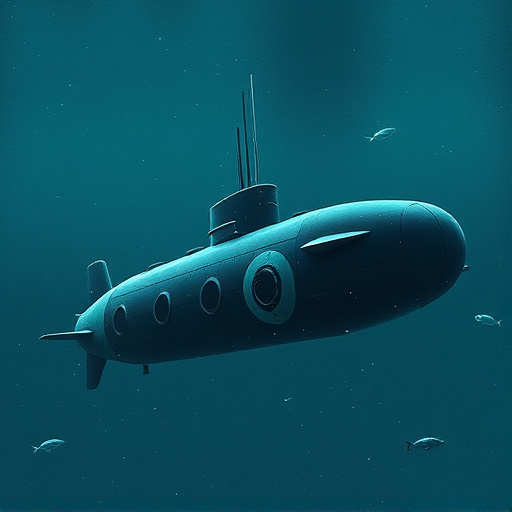Submarines have evolved from silent hunters to versatile, indispensable assets in modern naval warfare. The evolution of submarine technology has granted them unparalleled stealth and maneuverability, transforming them into multi-purpose platforms. From surveillance and intelligence gathering to strike capabilities, submarines play a crucial role in strategic deterrence, especially with their nuclear arsenals. This article explores the diverse mission profiles of submarines, their growing importance in naval strategies, and the challenges and future prospects of submarine warfare.
The Evolution of Submarine Technology
The evolution of submarine technology has been a game-changer in modern naval warfare, transforming undersea operations from rudimentary to highly advanced capabilities. Historically, early submarines were clunky and relied on manual propulsion, but technological advancements have since revolutionized their design and functionality. Modern submarines are now sleek, powerful, and equipped with cutting-edge weaponry, making them essential assets for naval forces worldwide.
These advancements include the integration of sophisticated sonar systems for improved navigation and target detection, as well as advanced torpedo and missile systems that enhance their offensive capabilities. Additionally, improvements in battery technology have increased submarine endurance, allowing them to remain submerged for extended periods, which is crucial for stealth operations and mission effectiveness. As a result, submarines play a pivotal role in modern naval strategies, offering unparalleled versatility in both offensive and defensive maneuvers.
Unparalleled Stealth and Maneuverability
Submarines offer an unparalleled level of stealth and maneuverability beneath the waves, making them highly effective in modern naval warfare. Capable of operating at great depths, they can avoid detection by advanced sensors and radar systems, providing a significant tactical advantage. This stealth allows submarines to approach their targets undetected, enabling them to launch precise strikes or conduct surveillance missions with minimal risk of exposure.
Their maneuverability is equally impressive, as submarines can quickly change direction, depth, and speed, making them hard to track and engage. This agility is particularly valuable in confined coastal waters or narrow straits where traditional surface ships would struggle to operate. With their advanced propulsion systems, submarines can remain submerged for extended periods, conducting operations far from base, which further enhances their versatility and capability in modern naval engagements.
Diverse Mission Profiles: From Surveillance to Strike
Submarines are versatile assets in modern naval warfare, capable of executing a wide array of missions that span from surveillance and intelligence gathering to precision strikes. Their unique ability to operate discreetly beneath the waves provides them with a strategic advantage in both friendly and hostile environments. Equipped with advanced sensors, sonar systems, and communication technologies, submarines can detect, track, and report on enemy ships, aircraft, and underwater activities.
Beyond surveillance, these vessels play a crucial role in offensive operations, launching guided missiles and torpedoes to engage targeted adversaries. Their stealth capabilities enable them to approach enemy positions undetected, making them highly effective in covert operations and precision strikes against high-value targets. This versatility makes submarines indispensable assets for modern navies, capable of adapting to evolving threats and contributing significantly to overall operational success.
Strategic Deterrence and Nuclear Arsenal
Submarines play a pivotal role in modern naval warfare, particularly in strategic deterrence and the maintenance of a nuclear arsenal. These stealthy vessels are often referred to as the “unsung heroes” of national defense due to their ability to operate unseen beneath the waves. They serve as a formidable deterrent against potential adversaries, equipped with ballistic missiles capable of carrying nuclear warheads.
The strategic value of submarines lies in their discreet deployment and unparalleled striking power. Hidden from view, they can launch precision strikes or deploy special forces, ensuring a strong second-strike capability. This means that even if a conflict erupts, the ability to retaliate remains intact, making them an indispensable component of a nation’s nuclear deterrence strategy.
Challenges and Future Prospects of Submarine Warfare
Submarine warfare, despite its strategic advantages, faces several challenges in modern naval environments. One of the primary obstacles is maintaining stealth and invisibility while achieving operational objectives. With advanced sonar technologies and increasing sensor capabilities of enemy vessels, submarines must continuously evolve their propulsion systems and materials to reduce noise and thermal signatures. Additionally, as underwater tactics become more sophisticated, so do countermeasures, requiring constant innovation in submarine design and warfare practices.
Looking ahead, the future of submarine warfare promises exciting prospects with advancements in technology. Autonomous systems and artificial intelligence can enhance a submarine’s ability to navigate complex underwater terrains and engage targets autonomously. Improved communications and data-sharing capabilities will enable better coordination among submarines and surface vessels. Furthermore, the development of advanced weaponry, such as silent running engines and more powerful torpedoes, could significantly alter the dynamics of naval warfare, making submarines even more formidable forces on the ocean’s depths.
